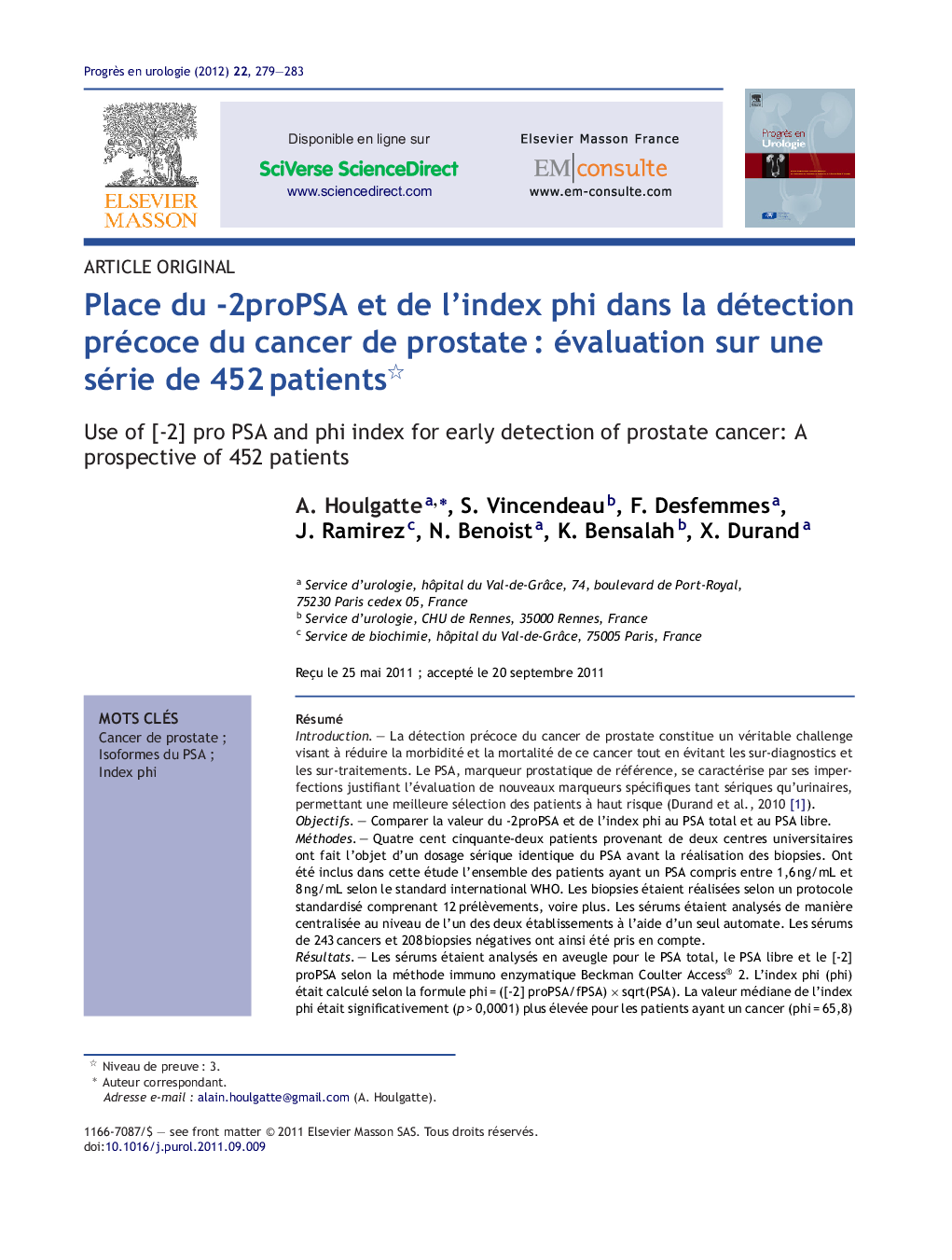| Article ID | Journal | Published Year | Pages | File Type |
|---|---|---|---|---|
| 3825125 | Progrès en Urologie | 2012 | 5 Pages |
RésuméIntroductionLa détection précoce du cancer de prostate constitue un véritable challenge visant à réduire la morbidité et la mortalité de ce cancer tout en évitant les sur-diagnostics et les sur-traitements. Le PSA, marqueur prostatique de référence, se caractérise par ses imperfections justifiant l’évaluation de nouveaux marqueurs spécifiques tant sériques qu’urinaires, permettant une meilleure sélection des patients à haut risque (Durand et al., 2010 [1]).ObjectifsComparer la valeur du -2proPSA et de l’index phi au PSA total et au PSA libre.MéthodesQuatre cent cinquante-deux patients provenant de deux centres universitaires ont fait l’objet d’un dosage sérique identique du PSA avant la réalisation des biopsies. Ont été inclus dans cette étude l’ensemble des patients ayant un PSA compris entre 1,6 ng/mL et 8 ng/mL selon le standard international WHO. Les biopsies étaient réalisées selon un protocole standardisé comprenant 12 prélèvements, voire plus. Les sérums étaient analysés de manière centralisée au niveau de l’un des deux établissements à l’aide d’un seul automate. Les sérums de 243 cancers et 208 biopsies négatives ont ainsi été pris en compte.RésultatsLes sérums étaient analysés en aveugle pour le PSA total, le PSA libre et le [-2] proPSA selon la méthode immuno enzymatique Beckman Coulter Access® 2. L’index phi (phi) était calculé selon la formule phi = ([-2] proPSA/fPSA) × sqrt(PSA). La valeur médiane de l’index phi était significativement (p > 0,0001) plus élevée pour les patients ayant un cancer (phi = 65,8) en comparaison aux patients à biopsies négatives (phi = 40,6). Pour une sensibilité équivalente, l’index phi permettait d’augmenter de façon importante la spécificité de détection du cancer de prostate par rapport aux autres marqueurs.ConclusionL’index phi apparaît actuellement comme le meilleur élément prédictif du cancer de prostate pour un PSA total compris entre 1,6 et 8 ng/mL selon le standard WHO, permettant ainsi de réduire de manière significative les indications de biopsies. Sa place comme indicateur des formes agressives reste à préciser.
SummaryIntroductionEarly detection of prostate cancer (Pca) is a real challenge to reduce morbidity and mortality while avoiding over-diagnosis and over-treatment. The prostate specific antigen (PSA) is characterized by its imperfections justifying the evaluation of new serum or urinary specific markers allowing a better selection of patients at risk of developing aggressive Pca.AimTo compare the value of -2pro PSA and phi index to total and free PSA.MethodsSerum sampled from 452 patients from two university centers were used to determine levels of PSA before performing biopsies. The patients were included in this study based on the PSA serum concentration between 1.6 ng/mL and 8 ng/mL according to the WHO international standard. All biopsies were performed according to a standardized protocol consisting of 12 cores or more. Sera were analyzed centrally in one of the two institutions with on a single analyzer. Sera from 243 prostate cancer and 208 negative biopsies patients have been taken into account.ResultsSera were analyzed blinded for total PSA, free PSA and [-2] proPSA using Access® immunoassay method from Beckman Coulter. The Prostate Health Index (phi) was calculated using the formula phi = ([-2] proPSA/fPSA) × sqrt (PSA). The median value of the phi index is significantly (P > 0.0001) higher for patients with cancer (phi = 65.8) compared to patients with negative biopsies (phi = 40.6). At a given sensitivity, the phi index significantly increases the specificity of detection of prostate cancer compared to other markers.ConclusionThe phi index currently appears as the best predictor of prostate cancer for patients with a total PSA between 1.6 and 8 ng/mL according to the WHO standard. The improvement in specificity of the phi index over tPSA could reduce significantly the numbers of unnecessary biopsies. Whether this new biomarker could be an indicator of aggressive prostate cancer remains to be confirmed.
